

Related Posts
Subscribe to Our Blog
Subscribe to receive email notifications every time we publish new insights, news, and thought leadership to our blog.

A good orientation and training program will provide volunteers with a positive experience and first impression of your organization.
Is your orientation and training program creating value and engagement?
Does your orientation and training program align with your mission and goals?
Besides creating a good first impression, orientation, and training an opportunity to get to know volunteers, create relationships, communicate your mission, set expectations, and provide resources.
Do not underestimate the importance of a good onboarding process for volunteers. According to reports, 69% of people are more likely to commit time to an organization with a structured onboarding program. Organizations with a standard onboarding process experience 50% greater new-hire productivity. It is important to set your volunteers up for success and provide them with value in exchange for their time and talent. Recruiting passionate volunteers and training them effectively will help your nonprofit nurture growth long term.
Here are four best practices for developing volunteer orientations with engagement in mind.
People learn and comprehend information in different ways. Some volunteers may be visual learners while others may digest information better through hands-on experience. Make sure that your volunteer orientations cater to all learning types. The best way to achieve this is by first providing volunteers with an example, followed by an action.
In other words, demonstrate how to perform a job function and then allow volunteers to try to replicate it. Provide volunteers with resources that they can refer to before, during, and after their orientation. Doing so will appeal to volunteers who learn best from an interpersonal standpoint. When optimizing volunteer orientations for different learning types, always consider your audience and their needs. Hands on activities make orientation more fun and engaging for supporters.
Feedback can help your nonprofit gauge insights that improve your volunteer program. Obtaining feedback about your volunteer orientations can help you improve them. Feedback provides the insights necessary to remove weaknesses and leverage strengths. How do volunteers feel about onboarding and training after completion? Are there parts of the process that could be improved?
A Harvard Business Review survey found that engagement leads to 4x productivity. Asking for feedback throughout a volunteer's journey with your organization, including feedback about their orientation experience, is a great way to increase engagement. Consider adding questions about orientation and training to your volunteer satisfaction survey.
One of the best ways to make new volunteers feel welcome, comfortable, and valued is by providing them with an experienced volunteer as a mentor. Experienced volunteers can show new volunteers how to overcome obstacles, be efficient, and drive the most value in their chosen role. Mentorship is also a great way to create friendships between volunteers.
A survey, completed by Management Mentors, found that mentorship leads to higher retention, improved morale, increased competency, and reduced training costs.
After the orientation process has ended for a volunteer communicate opportunities for them to get involved. Communications should be personalized, and frequent, and provide your volunteers with value. Volunteer management software can help your nonprofit move away from manual communications and streamline your communication efforts. For example, VolunteerHub offers email and text notifications.
One of the first opportunities your organization has to make a good impression on volunteers is during orientation, make the moment count. When done right, training can be a great opportunity to convert volunteers to long-term supporters by sparking passion and excitement around your mission. Make sure that your orientation process is optimized for different learning types, asks volunteers for feedback, provides volunteers with mentors, and communicates opportunities frequently to increase volunteer engagement.
Subscribe to receive email notifications every time we publish new insights, news, and thought leadership to our blog.